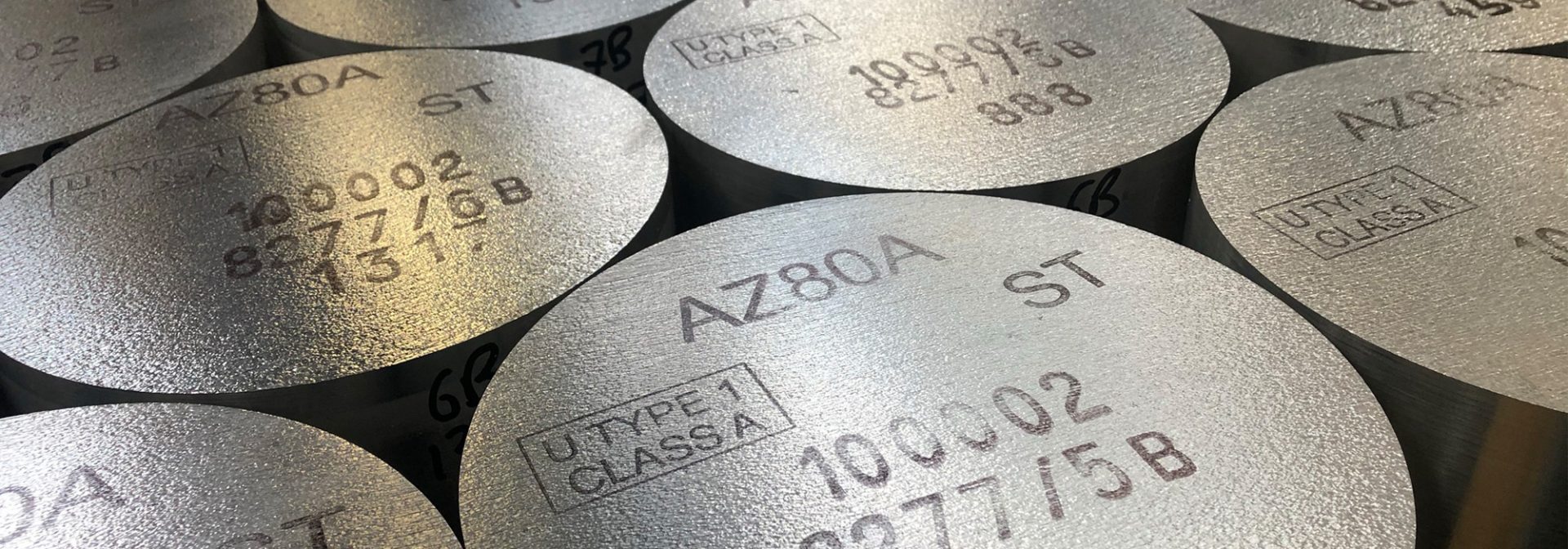
Elektron® RotaMag® AZ80A Forging Billet
Elektron® RotaMag® AZ80A is a wrought magnesium base alloy containing aluminium, zinc and manganese. Increased strength is obtained by artificial aging from the as-fabricated form. Elektron® RotaMag® AZ80A has a fine controlled microstructure for improved forging performance and consistent mechanical properties of the forged part.
Elektron® RotaMag® AZ80A forgings can be used where pressure tightness or machinability are required. That parts are dimensionally stable during and after machining is also an important design consideration. Forgings in Elektron® RotaMag® AZ80A find application in high strength parts for satellites, helicopter gearboxes and rotor hubs, bicycle frames, roadwheels, missile frames and interstage fairings, brake housings and landing gear struts.
- Uns No. M11800
- AMS4360
- ASTM B91-12
- FEDERAL QQ-M-40B
Aluminium: 7.8–9.2%
Zinc: 0.2–0.8%
Manganese: 0.12–0.5%
Magnesium: Balance
Billets are normally provided fully homogenised to promote ease of forging.
Specific gravity: 1.8
Coefficient of thermal expansion: 26 x 10-6K-1
Thermal conductivity: 76 Wm-1K-1
Specific heat: 1,100 Jkg-1K-1
Electrical resistivity: 145 nΩm
Modulus of elasticity: 45 GPa
Poissons ratio: 0.35
Melting range: 470–595˚C
The grain refinement of forging billets is a key factor affecting the ease of which the metal can be forged. Elektron® RotaMag® AZ80A forging billet undergoes a special grain refining process to ensure a fine uniform structure. Grain size is controlled to below 200 µm for 300 mm diameter billet.
Specification minimum tensile properties.
AZ80A-T5 die forgings
0.2% proof stress: 193 MPa
Tensile strength: 290 MPa
Elongation: 2%
AZ80-F die forgings
0.2% proof stress: 179 MPa
Tensile strength: 290 MPa
Elongation: 5%
Elektron® RotaMag® AZ80A, like all magnesium alloy forgings, machines faster than any other metal. Providing the geometry of the part allows, the limiting factor is the power and speed of the machine rather than the quality of the tool material. The power required per cubic centimetre of metal removed varies from 9 to 14 watts per minute depending on the operation.
All the normal chromating, anodizing, plating and finishing treatments are readily applicable.
As-fabricated (F) forgings can be converted to the precipitation treated temper T5 by heating to 177˚C for 16–24 hours, followed by air cooling.
Meet the Magnesium Forging Billet Team
Rick Tonge MBA
Product Line Manager
Europe, Middle East & Asia
Based in Manchester, UK, Rick supports our oilfield customers outside of North America. Partnering with our global customers, Rick enables his clients to design high performance products using Luxfer’s dissolving and non-dissolving material technology. Why not reach out to Rick today to discuss how Luxfer’s innovative material technology can work in your completion tools setup?

